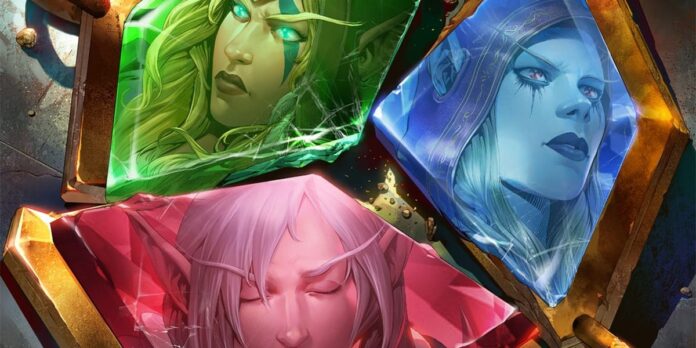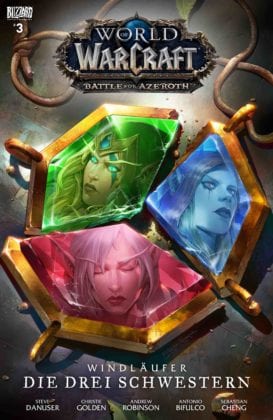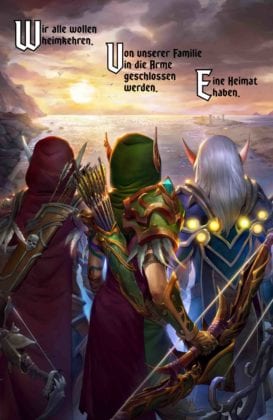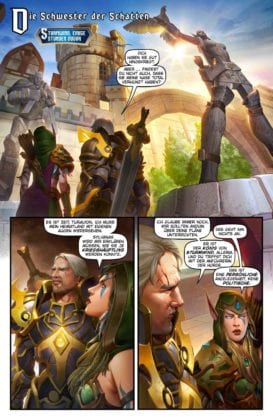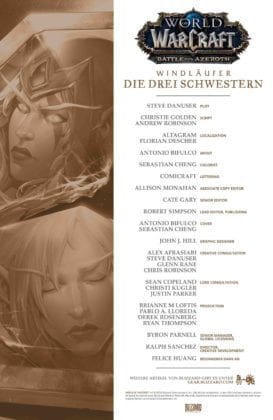Blizzard hat eine kleine Preview auf den dritten Comic zu Battle for Azeroth veröffentlicht. Dieses Mal geht es um die Windläufer-Schwestern.
Dank Blizzard darf ich euch heute die erste kleine Preview zu Windläufer – Die drei Schwestern präsentieren. Es handelt sich hierbei um den dritten Comic für Battle for Azeroth. Der erste Ausschnitt zeigt uns Szenen mit Alleria und was sie nach Legion plant.
Schon nach diesem kurzen Preview bin ich sehr gespannt auf den ganzen Comic. Für die große Ansicht könnt ihr einfach in die Galerie klicken.
Q&A zum Comic Die Drei Schwestern
Zudem hat Blizzard mir ein Q&A zur Verfügung gestellt, dass ich euch zeigen möchte. Aktuell bekommt ihr es nur in Englisch. Eine Zusammenfassung des Ganzen werde ich euch liefern, wenn der Comic vollständig erschienen ist.
Den Fragen stellten sich die Autoren Steve Danuser, Christie Golden und Andrew Robinson. Sie sprechen über jeden Weg, den die Schwestern gehen mussten.
Why did you decide to focus on the Windrunner sisters for one of the three comics leading up to Battle for Azeroth?
Christie Golden: In this situation, we already had the basis in an idea Steve had for a short story. . .
Steve Danuser: Yeah—the Windrunners are one of the cornerstone families of the Warcraft universe, with siblings on both sides of the Horde and Alliance conflict. Vereesa and Sylvanas have been in-game for a long time, but Alleria had been absent since the Second War. And when we went to Argus at the end of Legion, we finally got the chance to reintroduce Vereesa and Alleria to each other.
Once those two met, it became clear that a moment would arrive when all three sisters would come together to talk things out. And they each have such different histories and perspectives on the world. Alleria has been gone for a thousand years, from her point of view—and until recently she didn’t know about Sylvanas’s death, her being raised as a banshee, and then leading the Forsaken and the Horde.
I’d originally written a pitch for a short story that was going to be about these three sisters, with a section on each one of them from their points of view as they come together—but then we thought, instead of doing this as a short story or trying to make it work in the context of the game, what if this was the basis for a comic? So Christie took that idea next, and really started to make it come to life.
The three of you come from distinctly different writing backgrounds—Christie with long-form prose, Andrew with comics and animation, and Steve in games. How did that inform your collaborative process on this comic?
Christie: I’m in love with the word, so I’ve had to learn to pare things down for a medium like this. That’s where Andrew’s depth of experience with comics and animation was invaluable.
Steve: We all love telling stories, and we all want to see great stories told in the mediums that we touch. And it’s about finding the right story for the right medium. Some things just work better within the games; some work better in a novel; others work better in comics.
Christie: And with a universe like Warcraft, they can really feed into each other. I worked with Vereesa and Sylvanas a lot in War Crimes, so I was able to bring in a lot of callbacks to that in this comic—which in turn were callbacks to the game. One my personal favorite Horde quests, which I know other people love too, is The Lady’s Necklace. It’s such a sad, beautiful story. So I thought, what if their mother made a necklace with three gems and gave that to Alleria? And then Alleria gave them all a locket containing one of those gems? That element ended up in War Crimes, and that’s what brings Vereesa and Sylvanas together. Now, finally, we have a chance to bring all three of them together. The necklaces play an important symbolic role.
As Steve mentioned, Alleria and Turalyon have been away from Azeroth for 1,000 years, from their points of view. How does that impact their perspectives on the state of the world?
Steve: It’s hard to conceive of those kinds of things—how many lifetimes they lived out there, versus the one lifetime they had on Azeroth so long ago. That led us to the moment in the comic preview where they’re standing at their own statues outside Stormwind. If you came back to a world you left a thousand years ago and found out people thought you were dead and built statues to honor you, you’d probably go see your statue, right? That’s a very “human” thing to do, and a way to reconnect with the world.
We released an audio drama called “A Thousand Years of War” where we explored this too, and how everything Alleria and Turalyon were doing was for their son, Arator. Arator is an anchor of sorts for Alleria because, as we show in the comic, she’s touched the Shadow; she’s touched the Void. In-game, she tells people about how “the voices” are always there, even though when she’s talking with people, she appears totally under control. But in the comic, there are panels that are literally filled with voices saying, “Kill them! Kill them! Murder them! Free yourself!” That’s something that we really couldn’t have done as well in any other medium.
Andrew Robinson: And that’s one of the reasons this sort of cross-platform storytelling works so well. Each of these things informs the other, and in such a way that you can enjoy the game or this comic without knowing everything else that’s happened. But if you do the quests and then listen to the audio drama and read the book and the comic, you can get a deeper understanding, and it can mean more to the player emotionally.
In the comic, Turalyon advises Alleria to tell Anduin about her plan to meet with Sylvanas. Is Turalyon’s dedication to the Alliance something he’s carried with him during those thousand years, or was it reinforced by recent events?
Steve: I think it’s a combination. He definitely has an incredibly strong history with the Alliance. He was one of the founding paladins. He knew lots of heroes who lost their lives or made sacrifices along the way. All that background comes into play when meeting the heroes and champions of modern Azeroth.
Christie: And at this point in the story where the comic takes place, he’s already worked with Anduin. He’s already seen Anduin dealing with the Light and trying to do good in the world. Also, he’s courteous—he’s their host!
Andrew: And it’s not like they just landed five minutes ago. In the comic, they’ve probably been back for roughly a month or so.
Steve: Yeah—we see Turalyon in one of the quest lines players can do now to recruit one of Battle for Azeroth’s new Allied Races, the Lightforged Draenei. They’re part of the Army of the Light that Turalyon had out in the Twisting Nether and fighting the demons on Argus. We see him interacting with Anduin a bit and being their advocate saying, “We have this army of soldiers. You’re going to need soldiers. I know how to command them.”
The Windrunner sisters have had all led radically different lives. What would you say is the defining characteristic of being a Windrunner—that one thing that, despite all their differences, they still share in common?
Andrew: I think that question is why this comic exists. They haven’t seen each other in a very long time, and they want to find out what still makes them a family.
Christie: I think that’s reflected in the first line of the comic. Each of us wants to go home, to have a family.
Steve: Before Sylvanas was killed, before Alleria went off, they were all united in their love of their country, of Silvermoon, of Quel’Thalas, the Sunwell. And the Windrunners had been hugely important in the history of the high elves—so to see that chipped away and broken has certainly affected each of them in different ways. But I think they all feel strongly about what they consider family—they just have different perspectives on it now.
For Alleria, she decides that in order to save her son, in order to preserve her family, she has to fight a war, no matter how long it takes or what the cost. For Vereesa, she loses her husband Rhonin when the Horde attacks Theramore, and dedicates herself to making sure there’s a better world for her twin sons. As for Sylvanas—I think she’s had to redefine, more than anyone, what family means to her.
But I think they still have those same drives and those same commitments. Clearly they have some different priorities, but there’s still a commonality there that plays into this comic. But the question is, are those similarities enough to connect them in the long run?
When you were initially conceiving of the comic, what possibilities were you exploring in terms of how the sisters might react to each other now?
Steve: Christie had written these great scenes between Sylvanas and Vereesa in the War Crimes novel, and I think we saw one possible outcome there. Vereesa almost committed to joining Sylvanas, setting aside the life that she had to be with her sister. And how does Sylvanas feel about Vereesa walking away from that? That’s a thread that’s never been resolved.
In Legion, once Vereesa tells Alleria about what Sylvanas has done, Alleria’s response is along the lines of, “I can’t believe—I refuse to believe—that my sister would ever do those things. And I can’t believe my sister would ever side with the Horde.” There are so many potential outcomes, and so much tension. You never know how those family reunions are going to play out—you want to see what happens, and yet you don’t.
Despite being on opposite sides, Alleria and Sylvanas have both stood up to be leaders for a group of people who have been outcast. . . .
Steve: Yeah—another one of our Allied Races in Battle for Azeroth is the Void Elves, and as you say, they are another group of outcasts from what is now the blood elf society. Alleria sees them as like-minded people and decides to champion them—which is essentially what Sylvanas did for the Forsaken. But do Alleria and Sylvanas see that commonality? It’s often hard to recognize what those closest to you are going through. And sometimes you’re just too locked into your own perspective.
You can’t forget that the backdrop of all this is that a war is brewing. We wanted to set the story at this particular point in time—after the events of the Argus campaign, but prior to the events of Before the Storm—because really, the only time these three sisters could come together this way is right now.
The first page of the comic is a single panel of the three sisters together, sharing what appears a peaceful moment after the events of the rest of the comic. Why did you decide to begin the story with that image and that moment?
Christie: One of the things that comics can do is really let the visuals tell the story. There are a couple of places where we pull back from the dialogue and close in on the sisters, letting the images carry you through. I wanted that first panel from the outset—it was kind of a key to something that comes later, but I also wanted to start with this moment where it feels like all things are possible.
Andrew: And we want the reader to feel like, “Whoa, this is amazing! How did they finally get to this moment? What are they gonna do next?” And then the reader can think about that context as the story unfolds.
Can you talk a bit about how you came to work with the artists for this comic? What was you process like?
Christie: When we set out to create a comic, we look at a range of different styles and artists, and try to find the right fit for the story we want to tell. One thing about this particular comic is that it’s centered around three women—powerful, strong, beautiful, legendary, not-quite-human figures—so we really needed someone who could capture what made these characters immediately admirable and strong. . . .
Andrew: And someone who could capture their expressiveness. One of the most important things to me, especially in a story of this nature, is to see the emotion you’re trying to convey expressed through the art.
Steve: And even though these characters are siblings, they each have a unique demeanor, and I think the artist captured what makes them distinct beautifully.
One last question: Does Vereesa know that Sylvanas meant to turn her undead if she would have gone through with the plan in War Crimes and joined her sister’s side?
Christie: I think she has no idea. Why would she? Why would Sylvanas tell her? And what’s fun about that is Sylvanas doesn’t think this is a bad thing at all!
Andrew: Of course, Sylvanas thinks they’re just going to be together . . . forever!
Christie: Sylvanas is probably thinking Vereesa will just leave her kids, so she doesn’t have to worry about them anymore; they can just rule together, and it’s going to be great.
Steve: One of the interesting things about writing Sylvanas is that if you look at it from a purely human perspective, she does a lot of horrible things. You might recoil at the thought of someone killing her own sister just to be together. But when you think about what’s always driven Sylvanas—preserving her family, making sure her people endure—then she’s doing the same kinds of things she did before, just in different circumstances.
Andrew: I would also say that Sylvanas is ineffably lonely. She commands an army, but she has no one she can truly identify with. And here’s this sister she has so many fond memories of—from her perspective, she’s preserving her family, and making it so she’ll never be alone.
Steve: We all have those things with family where we ask, “Why can’t you understand the choices I’m making? We’re aligned in so many ways, and I’m doing this for the same reasons I did everything before—why can’t you see that?” But sometimes, when you’re looking at it from the outside, it’s hard to look past the horror and the cost. These three still have a lot in common, and this comic is about finding out . . . is that enough to keep them together, or will they forever be separated?
